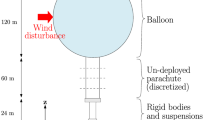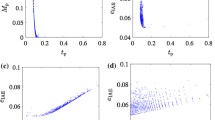Abstract
Achieving precision pointing performance plays a decisive role in future space missions. Pointing performance is specified by a set of requirements consisting of absolute, window- and stability-time errors. The European Cooperation for Space Standardization categorizes this set in the following pointing performance error indices: absolute performance error (APE), mean performance error (MPE), relative performance error (RPE), performance drift error (PDE) and performance reproducibility error (PRE). The analysis of pointing error indices in time-simulations is straightforward as error data time-series can be described by standard statistics. However, for design purposes there exists no method that can directly and systematically handle control loop performance in terms of window- and stability-time pointing error indices. In this article we extend the standard multi-objective H 2/H ∞ control problem to explicitly take into account requirements on pointing error index performance. The main topic, however, is the derivation of a control design approach that subjects the closed-loop control system to only one matrix criterion, the H ∞-norm. Therefore an optimization is set up to map pointing error index requirements into closed-loop specifications. The advantage of this approach is that the derived closed-loop specifications serve as indicators for the direct identification of design drivers, limits of performance and eventually systematic design trade-offs. Unlike in multi-objective H 2/H ∞ control design approaches, this can be done even before controller synthesis, and thus independently of the specified control problem feasibility. Moreover, the derived approach enables control design in the H∞ closed-loop shaping framework. Thus, various design objectives including pointing performance and robustness can be treated with one matrix criterion.












Similar content being viewed by others
References
Winkler, S., Cirillo, F., Ergenzinger, K., Ott, T., Wilhelm, R., Zaunick, E.: High-precision attitude determination and control of the EUCLID spacecraft: challenges and solutions. In: 8th International ESA Conference on Guidance, Navigation and Control Systems, Karlovy Vary (2011)
Schull, U., Knigge, T.: Geo-Oculus: A Mission for Real-Time Monitoring through High Resolution Imaging from Geostationary Orbit. EUMETSAT Meteorological Satellite Conference, Darmstadt (2008)
ECSS. “Pointing Performance Standard ECSS-E-ST-60-10C”, ESA-ESTEC Requirements and Standards Division (2008)
Lucke, R.L., Sirlin, S.W.: San Martin A.M.: New definition of pointing stability: AC and DC effects. J. Astron. Sci. 40(4), 557–576 (1992)
Pittelkau, M.E.: Pointing error definitions, metrics, and algorithms. Am. Astron. Soc. AAS 03–559, 901 (2003)
Scherer C.W.: Mixed H2/H∞ control. In: Isidori, A. (ed.) Trends in Control: A European Perspective. Springer, Berlin, pp. 173–216 (1995)
Scherer C.W.: An efficient solution to multi-objective control problems with LMI objectives. Syst. Control Lett. 40(1), 43–57 (2000)
Wong, E., Breckenridge, W.: An attitude control design for the Cassini spacecraft. In: AIAA Guidance, Navigation and Control Conference, Baltimore (1996)
Kia, T., Bayard, D.S., Tolivar, F.: A Precision Pointing Control System for the Space Infrared Telescope Facility (SIRTF). Jet Propulsion Laboratory Technical Report, Pasadena (1997)
Bayard, D.S.: High-precision three-axis pointing and control. Encyclopedia of Aerospace Engineering. Wiley, New York (2010)
Magarottot, E., et al.: H 2/H ∞ Control design: LMI techniques for space applications. In: IEEE International Conference on Control Applications, Trieste (1998)
Frapard, B., Griseri, G., Guyot, P.: Industrial use of H ∞ optimisation for high performance laser communication pointing system: the SILEX application. Automatisierungstechnik 53(10) 503–512 (2005)
Skogestad, S., Postlethwaite, I.: Multivariable Feedback Control: Analysis and Design. Wiley, New York (2005)
Zhou, K., Doyle, J., Glover, K.: Robust and Optimal Control. Prentice-Hall, Englewood-Cliffs (1996)
Fichter, W., Schleicher, A., Bennani, S., Wu, S.: Closed-loop performance and limitations of the LISA pathfinder drag-free control system. In: AIAA Guidance Navigation and Control Conference (2007)
Bayard, D.S.: A state-space approach to computing spacecraft pointing jitter. AIAA J. Guid. Control Dyn. 27(3) (2004)
Stein, G., Doyle, J.: Beyond singular values and loop shapes. AIAA J. Guid. Control 14(1) (1991)
Boyd, S.P., Barratt, C.H.: Linear Controller Design: Limits of Performance. Prentice-Hall, Englewood-Cliffs (1991)
ESA Engineering Standardization Board. Pointing Error Engineering Handbook ESSB-HB-E-003, ESA-ESTEC Requirements & Standards Division (2011)
Ott, T., Benoit, A., Van den Braembussche, P., Fichter, W.: ESA pointing error engineering handbook. In: 8th International ESA Conference on Guidance, Navigation and Control Systems, Karlovy Vary (2011)
MATLAB®. Robust Control Toolbox, MathWorks (2011)
Christen, U.: Engineering Aspects of H∞ Control. Swiss Federal Institute of Technology, Zürich (1996)
Bendat, J.S., Piersol, A.G.: Random Data-Analysis and Measurement Procedures, 3rd edn. Wiley, Chichester (2000)
Ruth, M., Lebsock, K., Dennehy, C.: What’s new is what’s old: use of Bode’s integral theorem (circa 1945) to provide insight for 21st century spacecraft attitude control system design tuning. In: AIAA Guidance, Navigation, and Control Conference (2010)
Boyd, S.P., Vandenberghe, L.: Convex Optimization. Cambridge University Press, Cambridge (2004)
Ott, T.: Robust Precision Pointing Control Design for Satellites with Small-Angle Agility Constraints, PhD Thesis, Institute of Flight Mechanics and Control, University of Stuttgart (to be published)
MATLAB®. Optimization Toolbox User’s Guide, MathWorks (2011)
Saage, R., Ross, R., Schleicher, A., Fichter, W.: Controller design method for drag-free systems with micro-propulsion constraints. In: AIAA Guidance Navigation and Control Conference, Toronto (2010)
Acknowledgments
The results obtained and presented in this article have been developed under the ESA Network/Partnering Initiative with the title “Precision Pointing Control Design Under Agility Constraints“. Partners are the Institute of Flight Mechanics and Control of Universität Stuttgart, AOCS/GNC and Flight Dynamics Department of Astrium Satellites, Germany, and the Control Systems Division of ESA/ESTEC.
Author information
Authors and Affiliations
Corresponding author
Appendices
Appendix 1 Application example
In this section the precision pointing H ∞ control design approach introduced in this article is applied to a simple case study. The aim is to design a SISO controller for one axis of a satellite with the plant, G = J −1 s −2, where the moment of inertia J = 4,500 kg m2 and performance requirements are defined in Table 8. The requirements are given in mili-arcseconds (mas) and mili-Newton-meter (mNm).
The pointing error sources are modeled according to Eqs. (11) and (12). The measurement noise shaping filter W n is shown in Fig. 13 and the disturbance noise shaping filter W d in Fig. 14.
Deriving the optimal closed-loop performance specification with the optimization in Sect. 6 yields the S- and T-specifications in Fig. 11. The specifications are put in context with the corresponding rms- and index-norm in Fig. 12. The limits of performance with respect to the system bandwidth are thus identified, which provides the basis for system trade-offs. At this point various specifications representing different hardware characteristics or design criteria can be traded.
As described in Sect. 7 the GS/T weighting scheme is used to set the specification bounds to ω BW3 in Fig. 12, thus just complying with the RPE requirement, e RPE,r , as stated in Table 7. This yields the closed-loop system in Fig. 15 with the specified and actual system performance listed in Table 9 and illustrated in Fig. 16.
The actual system performance is better than the specified due to the interpolation conditions applied during performance estimation in the transition region, \( \omega_{cS} < \omega < \omega_{cT} \), as mentioned in Sect. 7.3. The resulting margin for the relative pointing performance error, e RPE, is illustrated in \( \tilde{F}_{\rm RPE} \hat{G}_{ee} \), is plotted with respect to the actual system PSD, \( \tilde{F}_{\rm RPE} G_{ee} \). The more illustrative cumulated sum of the signal norm is shown in Fig. 17. The deviation of the actual PSD from the specified PSD for \( \omega \to 0 \) is due to residual spectral margins. This deviation could be reduced by selecting a more complex transfer function for W e when performing the optimization in Sect. 6.
Appendix 2 Performance measure derivation for sum of noise sources
The expected value of the sum of two stationary random noise processes \( x_{k} (t) \) and \( y_{k} (t) \) with zero mean value is:
with \( X_{k} (\omega ) \) and \( Y_{k} (\omega ) \) being the Fourier transforms of \( x_{k} (t) \) and y k (t), respectively, and \( X_{k}^{ * } (\omega ) \) and \( Y_{k}^{ * } (\omega ) \) being their complex conjugate. The expected value \( E[ \cdot ] \) is taken over the ensemble index k. \( G_{xx} (\omega ) \) and \( G_{yy} (\omega ) \) are the PSD and G xy (ω) and \( G_{yx} (\omega ) \) are the cross-spectral densities of \( x_{k} (t) \) and \( y_{k} (t) \).
If \( G_{xy} (\omega ) \) and \( G_{yx} (\omega ) \) are not known, lower and upper bound assumptions can be made. The upper bound assumption is that \( x_{k} (t) \) and \( y_{k} (t) \) are fully cross-correlated. In that case the following inequality applies:
The lower bound assumption is that x and y are not cross-correlated, meaning that:
In the precision pointing control problem defined in Sects. 3 and 4 the PSD of the output signals, e and u, are the input noise PSD, \( G_{nn} \) and \( G_{dd} \), of w n and w d transformed by the closed loop system, \( {\mathbf{H}}_{\rm CL} \), in Fig. 5 according to Eq. (2):
The PSD at e and u written in terms of the transformed input PSD thus is:
In Eqs. (28)–(31) the input noise processes, w n and w d , are assumed to be not cross-correlated because they originate from independent sources. Consequently, \( G_{nd} = G_{dn} = 0 \) and if \( {\mathbf{H}}_{\rm CL} \) is augmented by \( W_{n} \) and \( W_{d} \) at its inputs, Eq. (43) can be simplified to:
by remembering that in Eqs. (11) and (12) the PSD are written as \( G_{nn} = W_{n} N_{ww} W_{n}^{*} \) and \( G_{dd} = W_{d} N_{ww} W_{d}^{*} \, \) with \( N_{ww} = 1 \). The augmented \( {\mathbf{H}}_{\rm CL} \) thus corresponds to \( {\mathbf{H}}_{ 2 2} \) of Eq. (27). Substituting \( {\mathbf{H}}_{\rm CL} \)by \( {\mathbf{H}}_{ 2 2} \) and simplifying Eq. (43) leads to
If the input noise processes are cross-correlated, but the cross-spectral densities \( G_{nd} \) and \( G_{dn} \) are unknown, a worst case \( G_{ee} \) and \( G_{uu} \) can be determined by setting the transformed \( G_{nd} \) and \( G_{dn} \) to its upper bound defined by Eq. (40):
Rights and permissions
About this article
Cite this article
Ott, T., Fichter, W., Bennani, S. et al. Precision pointing H∞ control design for absolute, window-, and stability-time errors. CEAS Space J 4, 13–30 (2013). https://doi.org/10.1007/s12567-012-0028-z
Received:
Revised:
Accepted:
Published:
Issue Date:
DOI: https://doi.org/10.1007/s12567-012-0028-z









